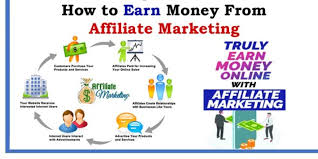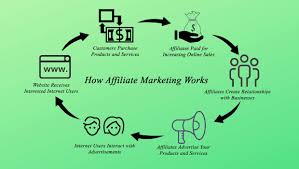Why Affiliate Marketing Rocks
What is Affiliate Marketing?
Affiliate marketing is like being a matchmaker for products and buyers—you promote stuff you love, and when someone buys through your unique link, you earn a commission. It’s that simple! You don’t create the product, handle shipping, or deal with customer service—just share links and cash in. From Amazon’s Associate Program to niche software affiliates, there’s something for everyone. In 2025, affiliate marketing is a low-risk, high-reward way to earn passive income.
Benefits for All Ages
Affiliate marketing is the ultimate side hustle, no matter your age. Here’s why it’s a hit:
-
Low Startup Costs: Start with just a laptop and internet—no fancy office needed.
-
Flexible Hours: Work at 2 AM or 2 PM, from anywhere in the world.
-
Passive Income Potential: Earn money while you sleep (or binge Netflix).
-
No Expertise Required: Beginners can learn as they go with free resources.
-
Scalable Earnings: From $100 to $10,000 a month, your hustle sets the limit.
Why It’s Booming in 2025
The affiliate marketing industry is on fire, with spending expected to soar past $15 billion globally (Statista, 2024). Why? E-commerce is skyrocketing, and companies love affiliates who drive sales without fixed salaries. Platforms like Amazon Associates and ClickBank make it easy to join, while social media and AI tools amplify reach. Whether you’re a teenager on TikTok or a retiree with a blog, affiliate marketing offers endless opportunities in 2025.
Read more: How to Earn Online Best Guide to Making Money in 2025
Starting with Affiliate Marketing
Pick a Profitable Niche
Choosing a niche is like picking a playlist—it should vibe with your interests and have an audience. Love fitness? Promote workout gear. Obsessed with tech? Review gadgets. High-paying niches in 2025 include:
|
Niche |
Commission Rates |
Popular Programs |
Demand Level |
|---|---|---|---|
|
Tech Gadgets |
1–8% |
Amazon, Best Buy |
High |
|
Health & Fitness |
5–20% |
ClickBank, MyProtein |
High |
|
Finance & Investing |
$5–$100 per lead |
Wealthfront, Coinbase |
Very High |
|
Beauty & Skincare |
5–15% |
Sephora, Ulta |
Moderate |
|
Online Courses |
20–50% |
Udemy, Teachable |
High |
Pro Tip: Use Google Trends to spot trending niches with low competition.
Choose the Right Platforms
Your platform is your stage—pick one that suits your style. Blogs are great for in-depth content, social media for quick engagement, and YouTube for visual demos. Beginners often start with blogs due to low costs (a WordPress site costs ~$100/year). Social media platforms like Instagram or TikTok are free but require consistent posting. Choose based on your audience—millennials love blogs, Gen Z flocks to TikTok.
Join Affiliate Programs
Ready to earn? Join affiliate programs that align with your niche. Here are top options:
-
Amazon Associates: Low commissions (1–10%) but vast product range.
-
ClickBank: High commissions (up to 70%) for digital products.
-
ShareASale: Diverse niches, from fashion to software.
-
CJ Affiliate: Big brands like Walmart and Home Depot.
-
Rakuten Advertising: High-paying programs for luxury and tech.
Sign up, get your unique affiliate links, and start promoting. Most programs are free to join but require a website or social media presence for approval.

Building Your Affiliate Platform
Create a Blog or Website
A blog is your affiliate marketing home base. Use WordPress or Wix to build a site for ~$100/year. Focus on a clean design, fast loading times, and mobile optimization—Google loves that. Write posts like “Top 10 Gadgets for 2025” with affiliate links embedded naturally. Optimize for SEO with tools like Yoast to rank higher. Don’t have a site yet? Start with a free blog on Medium to test the waters.
Alt text for image: Affiliate marketer designing a WordPress blog for affiliate marketing.
Leverage Social Media
Social media is your megaphone. Instagram, TikTok, and X are goldmines for affiliate marketing. Share product reviews, tutorials, or aesthetic posts with affiliate links in your bio (Instagram doesn’t allow clickable links in posts). On X, tweet tips like “Best budget laptops for students” with links. Engage with followers to build trust—reply to comments and join trending conversations. A viral TikTok about skincare could earn thousands in commissions!
Use YouTube for Affiliate
YouTube is a powerhouse for affiliate marketing. Create videos like “Unboxing the Latest iPhone” or “How to Budget with Finance Apps” and include affiliate links in the description. Keep videos engaging—use humor, clear visuals, and a strong call-to-action like “Click the link below to grab this!” Optimize titles and descriptions with keywords like “affiliate marketing review” to boost discoverability.
Crafting Affiliate Content
Write SEO-Optimized Posts
Great content is the backbone of affiliate marketing. Write blog posts that solve problems, like “Best Tools for Remote Work in 2025.” Use keywords like “affiliate marketing” naturally (1–2% density). Include LSI keywords like “passive income,” “online earning,” and “product reviews.” Structure posts with H2/H3 headings, short paragraphs, and bullet points for readability. Tools like Ahrefs can help find low-competition keywords to rank higher.
Create Engaging Reviews
Product reviews are affiliate marketing MVPs. Write honest, detailed reviews about products you’ve used or researched. Example: “Is this fitness tracker worth $100? Here’s my take.” Include pros, cons, and personal anecdotes to build trust. Embed affiliate links naturally, like “I bought mine here.” Add a comparison table to show how your product stacks up against competitors. Authenticity wins—don’t hype products you don’t believe in.
Use Visuals Effectively
Visuals make content pop. Use high-quality images or infographics to showcase products. For example, a blog post about cameras could include a photo of you using one (with alt text: “Affiliate marketer testing camera for affiliate marketing review”). Create comparison charts or infographics with tools like Canva. Videos or GIFs on social media can boost engagement—think quick product demos or before-and-after shots.
Read more: Affiliate Marketing Guide: All You Need To Know (2025)
Driving Traffic to Affiliate Links
Master SEO Strategies
SEO is your ticket to free traffic. Optimize blog posts with keywords like “how to earn with affiliate marketing” and LSI terms like “make money online.” Use internal links to related posts, like SEO tips for affiliates. Build backlinks by guest posting on niche blogs. Optimize for mobile—60% of searches are mobile (Google, 2024). Use tools like SEMrush to track rankings and tweak content.
Harness Social Media
Social media drives traffic faster than you can say “viral.” Post engaging content on Instagram, TikTok, or X—think tutorials, tips, or funny memes with affiliate links. Join niche groups on Facebook or Reddit to share your content (without spamming). Run giveaways or polls to boost engagement. Example: “Which gadget should I review next? Vote and check my link!” Engagement builds trust, which converts to clicks.
Explore Paid Advertising
Paid ads can supercharge traffic but require a budget. Start small with Google Ads or Facebook Ads, targeting keywords like “best fitness gear.” Set a daily budget of $5–$10 to test. Use retargeting to reach visitors who didn’t click your links. Track ROI with tools like Google Analytics—don’t spend $100 to earn $10 in commissions. Paid ads work best once you’ve mastered organic traffic.
Maximizing Affiliate Earnings
Optimize Conversion Rates
Clicks are great, but conversions pay the bills. Optimize your site with clear calls-to-action, like “Grab this deal now!” Use A/B testing to try different button colors or link placements. Add trust signals like customer testimonials or “As seen on” badges. For example, a review post could include a “Buy Now” button near the top. Higher conversions mean more commissions.
Diversify Income Streams
Don’t rely on one affiliate program. Join multiple programs to spread risk—Amazon for physical products, ClickBank for digital ones. Add other income streams like sponsored posts or digital products (e.g., an eBook on “Affiliate Marketing for Beginners”). A blog with affiliate links could also earn through display ads via Google AdSense. Diversification protects you if one program changes terms.
Track and Analyze Performance
Data is your co-pilot. Use tools like Google Analytics or ClickBank’s dashboard to track clicks, conversions, and earnings. Identify top-performing posts or links—maybe your “Best Laptops” post converts better than “Best Headphones.” Double down on what works and tweak what doesn’t. Set monthly goals, like increasing clicks by 10%, to stay motivated.
Avoiding Affiliate Pitfalls
Steer Clear of Scams
Not all affiliate programs are legit. Avoid “get-rich-quick” schemes promising thousands overnight. Stick to reputable platforms like Amazon, ShareASale, or CJ Affiliate. Research programs on X or Reddit for reviews. Red flags include high upfront fees or vague commission structures. Trust your gut—if it sounds too good to be true, it probably is.
Stay Compliant with Rules
Affiliate marketing has rules. Disclose affiliate links to comply with FTC guidelines—add a note like “This post contains affiliate links” at the top of your content. Follow platform policies (e.g., Amazon bans linking in emails). Non-compliance can lead to account bans or lost earnings. Stay honest and transparent to build trust with your audience.
Avoid Over-Promotion
Nobody likes a pushy salesperson. Don’t spam affiliate links in every post—it turns readers off. Focus on value—solve problems, share tips, and recommend products genuinely. For example, a blog post about “How to Work from Home” could mention a laptop with one affiliate link, not ten. Quality over quantity keeps your audience engaged and clicking.
Scaling Your Affiliate Business
Automate Your Workflow
Time is money, so automate repetitive tasks. Use Zapier to schedule social media posts or send follow-up emails. Set up email templates for pitches or client communication. Tools like Calendly streamline scheduling meetings with brands. Automation frees up hours for creating content or sipping that latte you’ve been eyeing.
Outsource Content Creation
Swamped with work? Outsource blog posts or social media content to freelancers on Upwork or Fiverr. Hire writers for $20–$50 per post or graphic designers for visuals. Focus on strategy and promotion while freelancers handle the grunt work. Ensure quality by setting clear guidelines and reviewing work before publishing.
Expand to New Niches
Once you’ve mastered one niche, branch out. A fitness blogger could add nutrition or wellness products. Test new niches with small campaigns—a few blog posts or TikTok videos—to gauge interest. Use Google Trends to spot emerging trends, like sustainable products or AI tools. Expanding niches boosts earning potential without starting from scratch.

FAQs About Affiliate Marketing
1. What is affiliate marketing, and how does it work?
Affiliate marketing involves promoting products and earning commissions for sales via your unique links. Join programs like Amazon Associates, share links on your blog or social media, and earn when someone buys. It’s low-risk and beginner-friendly.
2. How much can I earn with affiliate marketing?
Earnings vary—beginners might make $100–$500/month, while pros can earn $10,000+/month. High-paying niches like finance or tech boost income. Success depends on traffic, conversions, and choosing the right affiliate programs.
3. Do I need a website for affiliate marketing?
A website helps but isn’t mandatory. You can use social media (Instagram, TikTok) or YouTube to share affiliate links. Blogs are ideal for SEO and long-term traffic, but platforms like Medium work for beginners.
4. How do I find affiliate programs to join?
Join reputable programs like Amazon Associates, ClickBank, or ShareASale. Search for programs in your niche (e.g., fitness, tech) on Google or check affiliate networks. Read reviews on X or Reddit to avoid scams.
5. Is affiliate marketing legit and sustainable?
Yes, affiliate marketing is legit and sustainable with the right strategy. Focus on quality content, build trust, and diversify programs. Stay compliant with FTC rules and avoid spammy tactics to ensure long-term success.
Read more: Best Affiliate Marketing Strategies To Follow In 2025
Conclusion
Affiliate marketing in 2025 is a thrilling way to earn money online, whether you’re a student, parent, or retiree. From picking a niche and building a platform to driving traffic and scaling profits, success comes from strategy, authenticity, and persistence. Avoid pitfalls like scams or over-promotion by focusing on value and compliance. With the right tools and hustle, you can turn clicks into cash. So, what’s stopping you? Start your affiliate marketing journey today and share your wins with us! Leave your thoughts in the comments!


2 thoughts on “How Affiliate Marketing help in Earning Best of 2025”